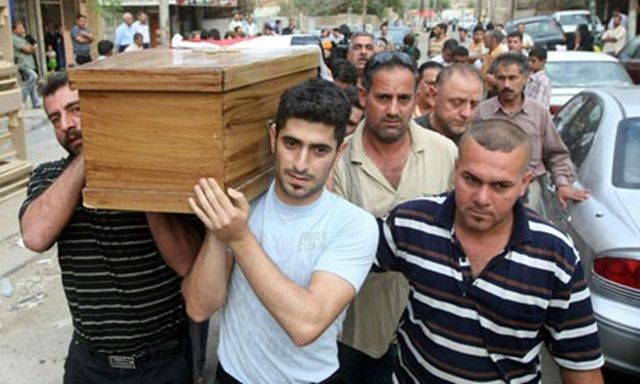
Gama’a Islamiya Addresses the Role of Copts in Modern Egypt as al-Qaeda Uses the Coptic Issue to Justify Baghdad Church Attack
Publication: Terrorism Monitor Volume: 8 Issue: 40
By:

The al-Qaeda affiliated Islamic State of Iraq (ISI) has released a statement claiming the October 31 hostage-taking at Baghdad’s Sayidat al-Nejat (Our Lady of Salvation) Syriac Catholic Church was carried out in order to free two Egyptian Coptic women they allege are being held prisoner in Coptic monasteries after converting to Islam. The ISI operation resulted in the death of 46 worshippers and clerics in a botched raid by Iraqi Special Forces supported by American advisors (Asharq al-Awsat, November 3). ISI’s statement indicated the movement was attempting to pressure the Egyptian Coptic Church (which has no connection to Rome) by attacking a Chaldean Catholic congregation: “Let these idolaters [i.e. Iraqi Christians], and at their forefront, the hallucinating tyrant of the Vatican, know that the killing sword will not be lifted from the necks of their followers until they declare their innocence from what the dog of the Egyptian Church is doing.” The ISI attack was quickly denounced by Cairo’s al-Azhar seminary (the most influential Sunni institution in the Islamic world) and Egypt’s Muslim Brotherhood (AFP, October 27).
The Coptic issue in Egypt has been raging since the beginning of the year. On the Coptic Orthodox Christmas Eve (January 6), six Copts and one Muslim were killed in a drive-by shooting outside a church in the Upper Egyptian town of Nag’ Hammadi. Three local Muslim men were arrested in what Copts came to refer to as the “Nag’ Hammadi massacre.” The attack was allegedly in response to the rape of a 12-year-old Muslim girl by a Coptic youth two months earlier. Government efforts to portray the killings as the isolated work of criminals rather than a sectarian attack led to protests in Upper Egypt and Cairo by Copts dissatisfied with the response of their clerics.
The issue of conversion continues to inflame relations between Copts and Muslims, with both groups accusing the other of abducting young women from their respective communities before forcing their conversion. Most harmful to Coptic-Muslim relations, however, was the alleged conversion of Camilia Shihata, a priest’s wife who disappeared on July 19 and is one of the two “detained women” cited by the ISI (the second, Wafa Constantine, left her husband, also a priest, in 2003 and lives in a Coptic institution, since telling state prosecutors she never converted to Islam). Coptic protests began after rumors circulated that Camilia had been abducted and forcibly converted to Islam. After several days she was located by state security forces and returned to the custody of her husband and male relatives. However, internet claims by influential Salafist Shaykh Abu Yehya reported that Camilia had converted to Islam and sought the shaykh’s protection before being returned to her family by security officials. Other Salafi shaykhs insisted she had been hidden in a monastery where she had been given mind-altering drugs by Coptic priests to force her to renounce Islam. Lawsuits were filed for her release in the midst of accusations Camilia was being tortured. Massive protests by Muslims and women’s organizations demanding her release were not stilled by declarations from state security and al-Azhar officials that she had never converted to Islam. A September 8 video shot by Muslim journalists in which Camilia denied the stories of her detention and physical intimidation in a Coptic monastery also had little effect. [1] Camilia’s “supporters” claimed the woman in the video was a double.
Bringing a resolution to the situation was complicated by unassociated comments on the Koran by Anba Bishoy, deputy to Coptic Pope Shenuda III. In a draft lecture intended for discussion by a gathering of Coptic clerics, Bishoy suggested a Koranic passage declaring Christians to be “infidels” was added after the death of the Prophet Muhammad, thus challenging the Muslim view that the Koran was received from the Angel Gabriel and recorded intact by the Prophet. Bishoy’s remarks were furiously rejected by Muslim scholars and al-Azhar’s Grand Shaykh demanded a formal apology, which was later given by Pope Shenuda on state television (Ikhwan Web, September 28).
The Bishop, who is emerging as somewhat of a loose cannon in the Coptic hierarchy, further widened the divide between Copts and Muslims by telling an Egyptian daily that “the Copts are the original inhabitants of Egypt. We are interacting lovingly with guests who descended upon us [i.e. the Arab Muslims who conquered Egypt in the Seventh Century].” The Copts style themselves as the descendants of the original Egyptians of the ancient world, but the characterization of Egypt’s Muslim majority (most of whom are descended in part from Coptic Egyptians who converted to Islam centuries ago) as “guests” was wildly inflammatory and led to demonstrators outside mosques chanting “We are not guests!” (al-Masry al-Youm, September 15).
At this point al-Jazeera TV aired an interview with influential Egyptian Islamist Dr. Salim al-Awa, who claimed Copts were storing Israeli-made arms in monasteries for use against Muslims in the creation of a Coptic Christian state (al-Jazeera TV, September 15). Pope Shenuda denounced al-Awa’s accusation that Copts were stockpiling Israeli-made arms and rejected al-Awa’s assertion that the Church acts as “a state within a state.” Pope Shenuda stated, “This is absolute nonsense. Just because the state responds to the demands of Christians, this doesn’t mean the church is more powerful than the state” (al-Masry al-Youm, September 20).
For the first time this year, Muslim-Christian relations reached a dangerously unprecedented level of deterioration, triggering interference by the government, religious leaders and civil society figures. Statements were issued by all parties emphasizing the need to re-establish the citizenship principle among Egyptians. Despite the GI statement condemning the Nag’ Hammadi violence, the group still practices symbolic violence and considers Copts to be a tolerated religious minority, rather than full citizens of Egypt. [2]
Articles highly critical of the Coptic Church are posted on the GI website. A GI op-ed dealing with Bishop Bishoy’s speculation on the Koran described the Christian religious leader’s words as “fires seeking the destruction of Egypt.” The GI website also adopted a call to prosecute Bishoy. The GI believes the Church is targeting the state’s sovereignty in the pursuit of a Christian religious state.
It is worth mentioning here that Christians were a primary target of the GI’s violence before the release of the GI’s 2003 “Revisions,” which saw the movement renounce political violence. Prior to the Revisions, targeting Copts’ interests and souls was part of the GI’s struggle against the regime. In one incident, the GI killed 17 Copts to avenge the killing of one Muslim in the Deirut massacre of June 19, 1992 (Deirut is a town in Middle Egypt’s Asyut governorate). The sectarian violence moved to al-Minya governorate in mid -1994. [3]
After assassinating Egypt’s former People’s Assembly speaker, Rifaat al-Mahjoub, in 1990 in retaliation for the killing of GI spokesman Ala Muhyi al-Din, the GI’s plan was comprised of three main strategies:
• Attack state security officers in charge of religious activities.
• Attack tourism establishments to weaken the regime’s economy.
• Play the Coptic card in a bid to embarrass the regime internationally.
After the release of the Revisions, the GI’s stand on the Copts took a new turn. The group even stopped asking for them to be classed as a religious minority within an Islamic state, leaving their status to the regime’s legislators. A GI figure, Asim Abdul Majid, wrote a book entitled Questions on Non-Muslims, in which he sought new relations with Copts, asserting the importance of the citizenship concept (Copts still have certain restrictions on their Egyptian citizenship based on the 7th century Dhimmi codes). The GI also links the Coptic issue to the stability and prosperity of the state. An article headlined “A call for reconciliation with the society” by the group’s chief theorist, Dr. Najih Ibrahim, reads, “The first step Islamic movements have to take is not to try to undermine the state’s authority and vice versa, as undermining both parties is the beginning of defeat and their strength is the way to victory.” [4]
Ibrahim believes protests by a vocal faction of Copts abroad to be attempts to apply international pressure on the Egyptian regime and are “methods to achieve undeserved and illegal gains.” [5] The GI asserts that Copts abroad and Pope Shenuda are the main causes of sectarian dissent in Egypt. However, it is the unwillingness of the Pope and his bishops to adopt a critical stance toward the government response to the Nag’ Hammadi incident that has led to the new phenomenon of widespread but peaceful protests by Copts in Cairo and Upper Egypt acting outside of the framework of the church as their representative.
One of the GI leaders and Shura Council members, Osama Abdul Rahman, describes the group’s attitude toward the Copts by saying, “We are committed to protecting them and being fair to them. In return, they are committed neither to question the Islamic faith nor to betray the country they live in.” [6]
In part, the GI’s stance on the Copts concludes that there is a tendency on the part of Copts to exaggerate disputes for the benefits of two elements: hardcore secularists and certain Copts abroad. This view is further fed by the steadfast position adopted by the Egyptian Church under Pope Shenuda since March 1971, which politicized the Church’s role by working in parallel with the regime, according to the GI’s Hussein Bastway. [7]
Though the GI’s approach to the Coptic issue has differed from that of certain prominent Salafist leaders, it is still conservative. The group is always ready for confrontation with Copts whenever sectarian tensions erupt, keeping an eye open for any Coptic political ventures. However, the GI never offers solutions to pressing issues such as the construction of churches or religious conversion. [8] The GI rejects the call from secular forces and civil society activists in Egypt for the institution of a state-of-law, the citizenship principle and the rejection of discrimination. The group insists on a concept of minority treatment for the Copts, not the concept of full citizenship. The Islamist movement also doubts the intentions and tendencies of the current Coptic Pope, which they see as an expression of Christian fundamentalist politics in Egypt. It will be worth watching to see whether the attack on Baghdad’s St. Joseph church dampens anti-Coptic outrage in Egypt or further inflames it.
Notes:
1. https://www.youtube.com/watch?v=c5csSijSaA8&feature=related.
2. <>.
3. The State of Religion in Egypt 4, Al-Ahram Center for Political and Strategic Studies, 1996, p.190.
4. An interview with Najih Ibrahim on the Islam Today website: https://islamtoday.net/albasheer/show_articles_content.cfm?id=72&catid=77&artid=8789.
5. Ibid.
6. Interview with Shaykh Osama Abdul Rahman on the following link: https://www.alriyadh.com/Contents/16-08-2003/Mainpage/POLITICS_14785.php.
7. Hussein Bastway “A Tour of the Life of Pope Shenuda, the Bishop of Firebrand Education,” https://egyig.com/Public/articles/books_studies/11/01607049.html.
8. Additions to churches or the construction of new churches continue to be regulated by the Ottoman-era khatt al-humayun (“imperial rescript”) regulations, while mosque construction is unhindered by any government restrictions. Reform of the existing regulations to create a single statute (“the common law on places of worship”) covering all religious facilities has been delayed for years in parliament.





